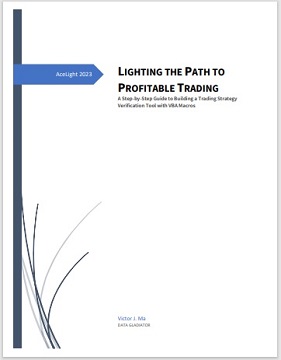A Beginner's Guide to Stock Trading Strategy through Technical Analysis
|
|
When it comes to stock trading strategy, technical analysis can be both
fascinating and daunting. It's like trying to read a foreign language that
even the natives don't fully understand. You stare at the charts and
indicators, hoping for a moment of clarity, suddenly, the market decides to
take a sharp turn…
So, grab your coffee, get comfortable, and let's
dive into the mystical world of technical analysis! Just don't blame us if
you start seeing candlesticks in your dreams.
What is Technical
Analysis?
Technical analysis is a method of analyzing stocks and
other securities based on their price and volume data. It involves using
charts and other technical tools to identify patterns and trends in the
price movements of stocks. Technical analysts believe that past price
movements can provide insights into future price movements.
There are two
main types of technical analysis: chart analysis and technical indicators.
Chart Analysis
Chart analysis involves studying stock price
movements on a chart to identify trends and patterns. The most common type
of chart used in technical analysis is a candlestick chart. Candlestick
charts show the opening, closing, high, and low prices for a stock over a
given time period. By studying these price movements, technical analysts can
identify trends, support and resistance levels, and other patterns that can
help them make trading decisions.
For example, consider the chart of
Apple Inc. (AAPL), we can go to finance.yahoo.com, search the stock symbol
AAPL, select "chart", then select "Candle". Now we can see a chart, each
candlestick represents one day of trading. The green candlesticks represent
days where the stock price increased, while the red candlesticks represent
days where the stock price decreased. By studying this chart, we can see
that AAPL has been in an uptrend since August 2020. We can also see that
there is a support level around $120, which has held multiple times. If the
stock price were to drop below this support level, it could be a signal to
sell.
Technical Indicators
Technical indicators are
mathematical calculations based on stock price and volume data. They are
used to identify trends and patterns in the price movements of stocks. Some
popular technical indicators include moving averages, relative strength
index (RSI), and stochastic oscillator.
Moving averages are one of
the most commonly used technical indicators. They are calculated by
averaging the price of a stock over a given time period. By plotting the
moving average on a chart, technical analysts can identify trends in the
stock price. For example, consider the following chart of Amazon.com Inc.
(AMZN) with a 50-day moving average:
Go to finance.yahoo.com, search
the stock symbol AMZN, select "chart", then select "Candle", and add
"Indicators", select "Moving Average", and set the parameters, just like,
setting Period to 50. In the chart, the blue line represents the 50-day
moving average. We can see that AMZN has been in an uptrend since May 2020,
as the stock price has consistently stayed above the moving average. If the
stock price were to drop below the moving average, it could be a signal to
sell.
Relative strength index (RSI) is another popular technical
indicator. It measures the strength of a stock's price movement by comparing
the average gains and losses over a given time period. RSI values range from
0 to 100, with values above 70 indicating an overbought condition and values
below 30 indicating an oversold condition. For example, consider the
following chart of Microsoft Corporation (MSFT) with RSI:
Go to
finance.yahoo.com, search the stock symbol MSFT, select "chart", then select
"Candle", and add "Indicators", select "RSI", and set the parameters, let's
say setting Period to 14. In the chart, the blue line represents the RSI. We
can see that MSFT has been in an overbought condition several times since
August 2020. If the RSI were to drop below 70, it could be a signal to sell.
Developing a Trading Strategy
To develop a successful trading
strategy using technical analysis, traders need to follow a few key steps:
1. Identify the trend: The first step is to identify the trend of the
stock. This can be done by studying the stock's price movements on a chart
and identifying whether the stock is in an uptrend, downtrend, or trading
range. Technical indicators such as moving averages can also be used to
confirm the trend.
2. Identify support and resistance levels: Support
and resistance levels are price levels where the stock has previously
bounced or stalled. These levels can be identified by studying the stock's
price movements on a chart and looking for areas where the stock has
previously found support or resistance. Traders can use these levels as
entry and exit points for their trades.
3. Use technical indicators
to confirm the trend and identify trading signals: Technical indicators such
as RSI and moving averages can be used to confirm the trend and identify
trading signals. For example, if the stock is in an uptrend and the RSI is
in an overbought condition, it could be a signal to sell.
4. Develop
a risk management plan: Trading stocks involves risk, so it's important to
develop a risk management plan. This should include setting stop-loss orders
to limit losses and using proper position sizing to manage risk.
 Whether
you're a beginner or an experienced stock trader, it's crucial to thoroughly
test any trading strategy before using it in live markets. This means
conducting both back-testing and forward-testing to evaluate the strategy's
effectiveness and identify potential flaws or weaknesses. Testing is a
necessary step in the development and implementation of any successful
trading strategy, regardless of its complexity. By using these testing
methods, traders can gain valuable insights into the performance of their
strategies and make adjustments as needed to optimize their results. So, if
you want to succeed in the stock market, make sure to prioritize testing
before putting your capital at risk. For more information, Click
LIGHTING THE PATH TO PROFITABLE TRADING: A Step-by-Step Guide to Building a Trading Strategy Verification Tool with VBA Macros to get the whole tutorial handbook for free! Whether
you're a beginner or an experienced stock trader, it's crucial to thoroughly
test any trading strategy before using it in live markets. This means
conducting both back-testing and forward-testing to evaluate the strategy's
effectiveness and identify potential flaws or weaknesses. Testing is a
necessary step in the development and implementation of any successful
trading strategy, regardless of its complexity. By using these testing
methods, traders can gain valuable insights into the performance of their
strategies and make adjustments as needed to optimize their results. So, if
you want to succeed in the stock market, make sure to prioritize testing
before putting your capital at risk. For more information, Click
LIGHTING THE PATH TO PROFITABLE TRADING: A Step-by-Step Guide to Building a Trading Strategy Verification Tool with VBA Macros to get the whole tutorial handbook for free!
And click Free Trial to download strategies testing tools, all for a 30-day Free Trial.
Click on Subscription to order more strategies testing tools to help your stock trading.
Example Trading Strategy
Let's take a look at an example
trading strategy using technical analysis. In this strategy, we will use a
combination of chart analysis and technical indicators to identify trading
opportunities.
1. Identify the trend: We will start by identifying
the trend of the stock we want to trade. Let's say we want to trade Apple
Inc. (AAPL). By studying the stock's price movements on a chart, we can see
that AAPL is in an uptrend.
2. Identify support and resistance
levels: Next, we will identify support and resistance levels for AAPL. By
studying the stock's price movements on a chart, we can see that there is
support around $120 and resistance around $145.
3. Use technical
indicators to confirm the trend and identify trading signals: We will use
two technical indicators to confirm the trend and identify trading signals:
the 50-day moving average and RSI.
We will use the 50-day moving
average to confirm the uptrend. If the stock price is above the moving
average, it's a signal to buy. If the stock price is below the moving
average, it's a signal to sell.
We will use RSI to identify
overbought and oversold conditions. If the RSI is above 70, it's a signal
that the stock is overbought and could be due for a pullback. If the RSI is
below 30, it's a signal that the stock is oversold and could be due for a
bounce.
4. Develop a risk management plan: Finally, we will develop a
risk management plan for our trades. We will set a stop-loss order at $115
to limit our losses if the stock price drops. We will also use proper
position sizing to manage risk.
Here's how we would execute this
strategy:
• Buy AAPL when the stock price is above the 50-day moving
average and the RSI is below 70.
• Sell AAPL when the stock price drops
below the 50-day moving average or the RSI is above 70.
• Set a stop-loss
order at $115 to limit losses.
• Use proper position sizing to manage
risk.
And there you have it, folks! A crash course on stock trading
strategy using technical analysis. Now, don't go quitting your day job just
yet. Remember, the stock market is like a rollercoaster - full of ups and
downs, twists and turns, and sometimes, it can make you want to throw up.
But with the right strategy, risk management plan, and a bit of luck, who
knows?
Remember, while technical analysis can be helpful in making
trading decisions, it's not foolproof. The market can be unpredictable and
volatile, so it's important to approach it with caution and a sense of
humor. Just remember the wise words of renowned investor Warren Buffett,
"Only buy something that you'd be perfectly happy to hold if the market shut
down for ten years." Good luck and happy trading!
|


|

Free Tutorial
Share
|
|
|
|